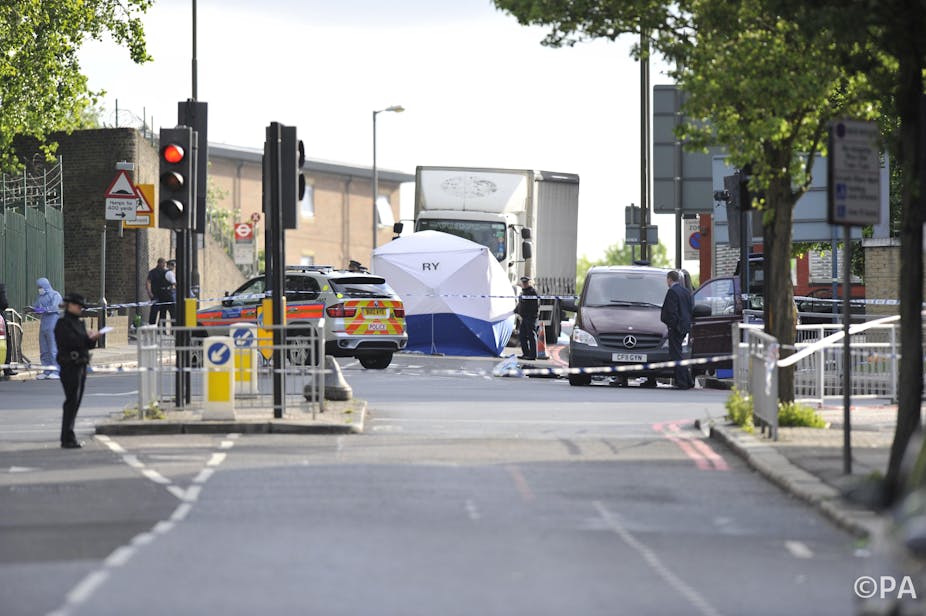While the full details of the awful events in Woolwich remain unclear, the attack has already revived heated debates about the risk of terror at home.
When building a profile of someone who allegedly commits public acts of violence, you can look at any one of a number of factors including social and family networks, experiences at school or at work and a range of beliefs and ideologies, as we did in the case of the Boston marathon bombings last month.
But to focus on Islam as a way of pinpointing where this, or the next atrocity comes from would be a mistake.
Cross-border identities
In the aftermath of the Woolwich incident, a suspect (apparently with a London accent) speaking into a video camera, said: “in our land our women have to see the same …”
This may seem a contradiction to some viewers, but recent research has demonstrated that through the news, through kinship ties, the internet and migration, ideas are exchanged and identities constantly negotiated that transcend national borders.
In some cases, not necessarily this one, this leads to people taking on the causes of other people they have never met, and regurgitating ideologies that attract them.
This isn’t new of course – in the 1970s the Red Army Faction claimed some of its violent bombings in West Germany were carried out on behalf of the Vietnamese people. It also justified its actions from the ideas of Karl Marx. Yet none of the group had been to Vietnam and one of the principal leaders – Andreas Baader – didn’t even read Marx until after he had been imprisoned.
In Japan during the 1980s and 1990s, a religious group called Aum Shinrikyo combined elements from several religions and set itself the mission of world salvation. Increasing acts of violence culminated in the 1995 release of poisonous gas on the Tokyo underground, which killed 12 and injured 5,500.
Both these cases are instructive, not least because more recent events tend to lead to an unhelpful focus on Islam. Too often, explanations of radicalisation focus on overly-simplistic causes: for every loner who acted violently there is another terrorist who seemed socially well adjusted and connected. Similarly there are poor and rich jihadists and religious and non-religious revolutionaries.
Violent extremists have included victims of state repression and citizens of democratic societies, immigrants in hostile host countries and those from indigenous communities. The simple fact is that violent extremists are the exception to the rule and for every apparent cause of violent action there are numerous examples of people with similar ideologies, in similar circumstances, who didn’t act violently.
Causes and catalysts
This doesn’t mean we shouldn’t try to identify causes, motivations and catalysts for violent action. Through my research, I’ve explored how we can identify and distinguish causes of radicalisation. Motivating factors include racial or religious discrimination, and economic or social exclusion.
But the role of non-negotiable, sacred beliefs - those beliefs that are set apart from everyday ideas and practices - also appears to be central in all forms of terrorism. This might encompass places such as the National Mall in Washington DC, rituals such as the state opening of Parliament or the Olympic Games or figures such as Muhammad.
We all hold non-negotiable beliefs and commitments. Understanding what these are and how they are defended is one part of the picture in understanding how someone becomes radicalised.
The Red Army Faction (RAF) held a sense of basic injustice, that American imperialism was crushing “the people”, and had a world view that made a stark division between “them” and “us” (the American and West German governments versus the RAF and the common people). They believed violence was the only acceptable answer to Western treatment of the Vietnamese and others.
In much the same way, some supporters of al-Qaeda ideology express deep-seated feelings of injustice linked to the American invasion of Muslim lands, opposing world views represented by the West versus Islam and violent interpretations of their myths and religious teachings that mark them out from non-violent Islamists and Muslims.
We are still researching how such non-negotiable ideas provide motivation or justification for violent action. Overly simple explanations, such as the role of Islam - or of religion in general - in triggering violence, have been shown to be false.

